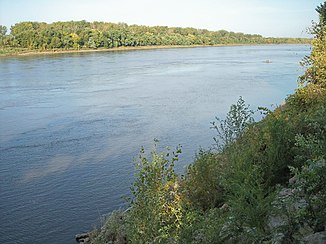Missouri River
The Missouri River [ mɪˈzʊɹɪˌɹɪvɚ ], nicknamed "Big Muddy" because of its high mud content , is the longest tributary of the Mississippi River and the longest river in the United States at 4087 kilometers , because it is longer than the stream into which it flows .
With this current, the Missouri forms the longest river system in North America and the fourth longest on earth as the Missouri-Mississippi .
River course
The course of the river largely follows the edge of the glaciation during the last ice age. One of the three source rivers of the Missouri, the Jefferson , has its source in the mountains of southwest Montana , four kilometers west of the town of Elkhorn near the watershed between the Atlantic and the Pacific . Another source river, the Madison , has its source in Yellowstone National Park, Wyoming. A third source river is the Gallatin River . The three rivers unite in Missouri Headwaters State Park seven kilometers northeast of the village of Three Forks in Montana and form the Missouri River from there.
The longer of these source rivers, the Jefferson River (328 km), emerges from the two rivers Big Hole River and Beaverhead River (in the upper reaches of the Red Rock River ). The source of the Red Rock River and thus the actual origin of the Missouri is about 45 kilometers east of West Yellowstone in northwestern Wyoming . The Red Rock flows into the Clark Canyon Reservoir and is then called Beaverhead. The Beaverhead takes up the Big Hole River north of the town of Twin Bridges and becomes the Jefferson River.
The Missouri is therefore kilometered along the Red Rock Beaverhead Jefferson Missouri line.
After the confluence of the two rivers mentioned seven kilometers northeast of Three Forks , the Missouri flows north through mountainous canyons and emerges from the mountains east of Great Falls , where great rapids historically mark the river's navigable boundary. The Giant Springs, which feed the Roe River (61 meters long!), Are also located here. It then flows eastward through the plains of Montana. 240 kilometers of the river and a strip of shoreline several kilometers wide are protected as the Upper Missouri River Breaks National Monument before the river is dammed in Fort Peck Lake . In the far west of North Dakota south of the village of Buford, the Yellowstone River flows into the Missouri; in fact, that one is wider than the Missouri. In Lake Sakakawea , where these two rivers meet, the Missouri crosses the border into North Dakota. It then flows southeast through this state and through South Dakota and along the northern and eastern fringes of Nebraska, and then forms the natural border between South Dakota and Iowa . It continues to flow past Sioux City and Omaha , forming the border between Nebraska and Missouri and the northern part of the border between Kansas and Missouri. At Kansas City, the river turns east through Missouri until it joins the Mississippi north of St. Louis on the Illinois border .
history
Missouri got its name from the historical inhabitants of the estuary, the Indian people of the Missouri . They were by their neighbors, the people of Illinois , wi-MIHs-oor-ita called what "with the wooden canoes" means. This indicates that the Missouri used dugouts and not canoes covered with bark or skins. The Missouri was very important for the expansion of the then still young United States to the west. The Louisiana Purchase made the river part of the United States and the Lewis and Clark expedition successfully used it to find a route to the Pacific Ocean . In 1829, the German naturalist Duke Paul Wilhelm von Württemberg (1797–1860) was the first European to find the sources of the Missouri. During the late 19th century, before the railways appeared, the river was an important route of transportation for goods and passengers. The use of paddle steamers on the upper half of the river facilitated the white settlement of Dakota and Montana. In the 20th century, the Upper Missouri was dammed for flood control, irrigation and hydroelectric power generation.
Catchment area
Its catchment area covers one sixth of the total area of the United States . The river, combined with the Mississippi, forms the fourth longest river system in the world. This extensive system of tributaries covers almost all of the semi-arid northern Great Plains of the United States and, through the Milk River , a small portion of Alberta , Canada . The longer tributaries extend westward from this ridge and drain parts of the eastern Rocky Mountains .
Web links
See also
Individual evidence
- ↑ Length of the Missouri. US Geological Survey, March 14, 2014, accessed May 2, 2015 .
- ↑ Michael McCafferty: Correction: Etymology of Missouri . In: American Speech , Vol 79, Issue 1, Spring 2004, page 32

